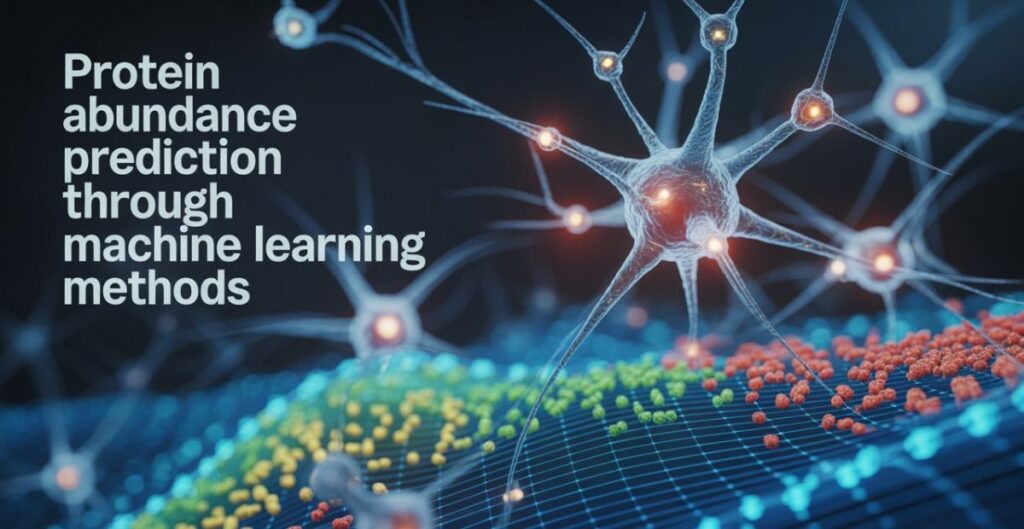Understanding how much of a certain protein exists in a cell is important in biology and medicine. This is called protein abundance. Thanks to new technologies, we can now use machine learning methods to make accurate guesses or predictions about this.
In this article, we’ll explore how protein abundance prediction through machine learning methods is changing the way scientists study proteins. These methods can look at amino acid sequences and find patterns that humans might miss.
As you’ll see, these predictions help with designing better drugs, understanding diseases, and learning how our cells really work.
- Introduction to Protein Abundance and Its Importance
- How Machine Learning Transforms Protein Abundance Prediction
- Key Methods for Protein Abundance Prediction
- Applications of Protein Abundance Prediction
- Tools and Frameworks for Protein Abundance Prediction
- Challenges and Future Directions
- Conclusion
- Frequently Asked Questions (FAQs)
Introduction to Protein Abundance and Its Importance
Every living thing has proteins, and they do most of the work inside cells. Some help build muscles, others carry oxygen, and some protect against viruses.
But how much of a protein is made depends on things like:
- The amino acid sequence (the order of tiny units that build the protein)
- How the protein folds into shape
- How quickly it’s broken down or used
Understanding protein synthesis regulation helps scientists know how cells grow, survive, and respond to changes. When proteins don’t work right or are made in the wrong amount, it can lead to diseases like cancer, diabetes, or infections.
How Machine Learning Transforms Protein Abundance Prediction
Machine learning is a type of computer science where computers learn from data. Instead of telling the computer exactly what to do, we give it examples, and it finds patterns. In this case, we give it information about protein sequences and teach it to guess how much of that protein is made.
Using machine learning, scientists can now:
- Look at just the amino acid sequence and predict abundance
- Understand how protein folding affects stability
- Make faster and cheaper predictions without long lab tests
One popular method uses a special computer model called a deep neural network. Some of these models are even based on tools like BERT, which was first used for understanding language. Now, it’s helping to understand biology too.
These models can find patterns related to:
- Protein expression prediction
- Conformational protein stability
- Mutation effects on proteins
- Hydrophobicity and polarity (how proteins mix with water)
Key Methods for Protein Abundance Prediction
D-I-TASSER vs AlphaFold: A Comparison of Structural Prediction Tools
Two popular tools for understanding protein shapes are AlphaFold and D-I-TASSER.
- AlphaFold uses AI to predict how proteins fold into 3D shapes. It changed the way scientists think about protein structure.
- D-I-TASSER also predicts protein structure but uses different techniques. In some studies, it worked better than AlphaFold for certain types of proteins.
Knowing the shape helps us learn how stable a protein is, and this matters because more stable proteins are usually more abundant.
These tools study things like secondary protein structure, alpha helix preference, and backbone conformation, which all affect how much protein is made and how long it lasts.
AF3Score: A Tool to Evaluate Structural Fitness in Prediction Models
AF3Score checks how “fit” a protein structure is — kind of like grading its quality. It looks at things like:
- Solvent Accessible Surface Area (SASA) — which shows how much of the protein is exposed
- Intermolecular interactions — how proteins stick together
- Hydrophobic core exposure, which can show if a protein is stable or not
AF3Score helps machine learning models learn better by giving them more accurate structural details.
PhysDock: Merging AI and Physics for Protein-Ligand Modeling
PhysDock combines machine learning with physics rules. It helps predict how proteins interact with other molecules, like medicines or nutrients.
It uses molecular dynamics simulation and hydrophobicity data to make smarter guesses. This improves predictions about protein-ligand binding, which is useful in drug discovery.
Applications of Protein Abundance Prediction
Designing Antibiotics Using Deep Learning: A Real-World Use Case
Scientists have used deep learning to design antimicrobial peptides — small proteins that kill bacteria. By understanding how mutations increase or decrease protein abundance, they can build peptides that work better against superbugs.
They use tools like MGEM-guided mutation to improve proteins and make them more effective.
Using METAGENE-1 and Machine Learning for Pathogen Surveillance
At USC, researchers created METAGENE-1, a tool that tracks and detects harmful microbes. It uses machine learning to study protein abundance prediction in yeast and other systems.
This kind of research helps in pandemic monitoring, early warnings, and finding new ways to fight diseases.
Tools and Frameworks for Protein Abundance Prediction
Machine learning needs data and tools to work. Here are some common frameworks:
- Python libraries like TensorFlow, PyTorch, and Scikit-learn
- Bioinformatics databases like UniProt, PAXdb, and AlphaFold DB
These help in predictive modeling in proteomics and even sequence optimization for metabolic cost, which means making proteins that cost less energy for cells to produce.
Example: Protein Abundance Prediction Through Python
Here’s a basic flow:
- Input: amino acid sequence
- Model: neural network trained on protein data
- Output: predicted protein abundance
This is useful for students or labs that want to experiment with protein prediction without needing a full lab setup.
Challenges and Future Directions
While machine learning is powerful, there are still challenges:
- Models need large amounts of clean, labeled data
- Post-translational regulation (what happens to proteins after they’re made) is hard to model
- The misfolding avoidance hypothesis is still debated, meaning we don’t fully understand how folding affects abundance
- Preprint protein engineering research is growing fast, but peer-reviewed studies are needed for confirmation
In the future, better data, more accurate models, and new tools like self-attention neural networks may unlock even deeper insights into how proteins work.
Conclusion
Protein abundance prediction through machine learning methods is changing the future of biology. With just a sequence of amino acids, we can now guess how much of a protein is made, how it behaves, and how it might respond to changes.
From helping design antibiotics to fighting pandemics, this blend of biology and AI is unlocking new doors. And as the tools keep improving, more young scientists, students, and healthcare workers will be able to use these breakthroughs to make the world a healthier place.
Frequently Asked Questions (FAQs)
What is protein abundance, and why does it matter?
Protein abundance means how much of a specific protein is found in a cell or tissue. It helps scientists understand how cells work and find treatments for diseases.
How is protein abundance measured in the lab?
Tools like mass spectrometry or fluorescent tags help scientists measure protein levels in different samples.
Can machine learning really predict protein abundance?
Yes. Machine learning looks at patterns in protein sequences to predict how much protein a cell will produce, often faster and cheaper than lab tests.
What machine learning tools are used to predict proteins?
Popular tools include AlphaFold, D-I-TASSER, and BERT-based deep learning models.
How does the amino acid sequence affect protein levels?
The sequence affects folding, stability, and function. Some sequences make proteins that last longer or fold better, leading to higher abundance.
What is the role of deep learning in predicting protein behavior?
Deep learning finds hidden patterns in big protein datasets, helping predict folding, function, and abundance — all from the protein’s sequence.






